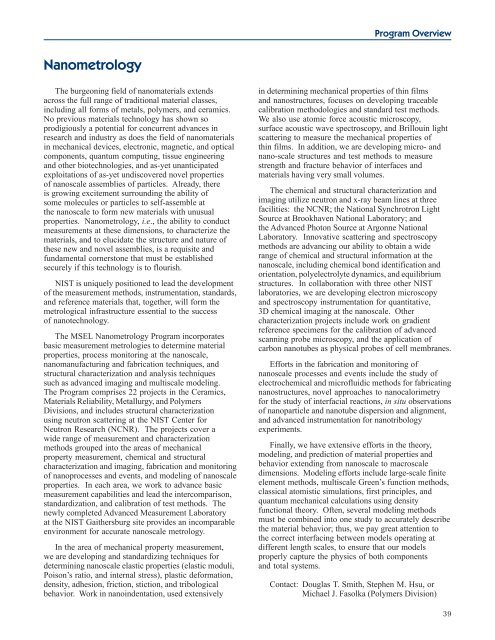Materials Science and Engineering Laboratory FY 2004 ... - NIST
Materials Science and Engineering Laboratory FY 2004 ... - NIST
Materials Science and Engineering Laboratory FY 2004 ... - NIST
You also want an ePaper? Increase the reach of your titles
YUMPU automatically turns print PDFs into web optimized ePapers that Google loves.
Nanometrology<br />
The burgeoning field of nanomaterials extends<br />
across the full range of traditional material classes,<br />
including all forms of metals, polymers, <strong>and</strong> ceramics.<br />
No previous materials technology has shown so<br />
prodigiously a potential for concurrent advances in<br />
research <strong>and</strong> industry as does the field of nanomaterials<br />
in mechanical devices, electronic, magnetic, <strong>and</strong> optical<br />
components, quantum computing, tissue engineering<br />
<strong>and</strong> other biotechnologies, <strong>and</strong> as-yet unanticipated<br />
exploitations of as-yet undiscovered novel properties<br />
of nanoscale assemblies of particles. Already, there<br />
is growing excitement surrounding the ability of<br />
some molecules or particles to self-assemble at<br />
the nanoscale to form new materials with unusual<br />
properties. Nanometrology, i.e., the ability to conduct<br />
measurements at these dimensions, to characterize the<br />
materials, <strong>and</strong> to elucidate the structure <strong>and</strong> nature of<br />
these new <strong>and</strong> novel assemblies, is a requisite <strong>and</strong><br />
fundamental cornerstone that must be established<br />
securely if this technology is to flourish.<br />
<strong>NIST</strong> is uniquely positioned to lead the development<br />
of the measurement methods, instrumentation, st<strong>and</strong>ards,<br />
<strong>and</strong> reference materials that, together, will form the<br />
metrological infrastructure essential to the success<br />
of nanotechnology.<br />
The MSEL Nanometrology Program incorporates<br />
basic measurement metrologies to determine material<br />
properties, process monitoring at the nanoscale,<br />
nanomanufacturing <strong>and</strong> fabrication techniques, <strong>and</strong><br />
structural characterization <strong>and</strong> analysis techniques<br />
such as advanced imaging <strong>and</strong> multiscale modeling.<br />
The Program comprises 22 projects in the Ceramics,<br />
<strong>Materials</strong> Reliability, Metallurgy, <strong>and</strong> Polymers<br />
Divisions, <strong>and</strong> includes structural characterization<br />
using neutron scattering at the <strong>NIST</strong> Center for<br />
Neutron Research (NCNR). The projects cover a<br />
wide range of measurement <strong>and</strong> characterization<br />
methods grouped into the areas of mechanical<br />
property measurement, chemical <strong>and</strong> structural<br />
characterization <strong>and</strong> imaging, fabrication <strong>and</strong> monitoring<br />
of nanoprocesses <strong>and</strong> events, <strong>and</strong> modeling of nanoscale<br />
properties. In each area, we work to advance basic<br />
measurement capabilities <strong>and</strong> lead the intercomparison,<br />
st<strong>and</strong>ardization, <strong>and</strong> calibration of test methods. The<br />
newly completed Advanced Measurement <strong>Laboratory</strong><br />
at the <strong>NIST</strong> Gaithersburg site provides an incomparable<br />
environment for accurate nanoscale metrology.<br />
In the area of mechanical property measurement,<br />
we are developing <strong>and</strong> st<strong>and</strong>ardizing techniques for<br />
determining nanoscale elastic properties (elastic moduli,<br />
Poison’s ratio, <strong>and</strong> internal stress), plastic deformation,<br />
density, adhesion, friction, stiction, <strong>and</strong> tribological<br />
behavior. Work in nanoindentation, used extensively<br />
Program Overview<br />
in determining mechanical properties of thin films<br />
<strong>and</strong> nanostructures, focuses on developing traceable<br />
calibration methodologies <strong>and</strong> st<strong>and</strong>ard test methods.<br />
We also use atomic force acoustic microscopy,<br />
surface acoustic wave spectroscopy, <strong>and</strong> Brillouin light<br />
scattering to measure the mechanical properties of<br />
thin films. In addition, we are developing micro- <strong>and</strong><br />
nano-scale structures <strong>and</strong> test methods to measure<br />
strength <strong>and</strong> fracture behavior of interfaces <strong>and</strong><br />
materials having very small volumes.<br />
The chemical <strong>and</strong> structural characterization <strong>and</strong><br />
imaging utilize neutron <strong>and</strong> x-ray beam lines at three<br />
facilities: the NCNR; the National Synchrotron Light<br />
Source at Brookhaven National <strong>Laboratory</strong>; <strong>and</strong><br />
the Advanced Photon Source at Argonne National<br />
<strong>Laboratory</strong>. Innovative scattering <strong>and</strong> spectroscopy<br />
methods are advancing our ability to obtain a wide<br />
range of chemical <strong>and</strong> structural information at the<br />
nanoscale, including chemical bond identification <strong>and</strong><br />
orientation, polyelectrolyte dynamics, <strong>and</strong> equilibrium<br />
structures. In collaboration with three other <strong>NIST</strong><br />
laboratories, we are developing electron microscopy<br />
<strong>and</strong> spectroscopy instrumentation for quantitative,<br />
3D chemical imaging at the nanoscale. Other<br />
characterization projects include work on gradient<br />
reference specimens for the calibration of advanced<br />
scanning probe microscopy, <strong>and</strong> the application of<br />
carbon nanotubes as physical probes of cell membranes.<br />
Efforts in the fabrication <strong>and</strong> monitoring of<br />
nanoscale processes <strong>and</strong> events include the study of<br />
electrochemical <strong>and</strong> microfluidic methods for fabricating<br />
nanostructures, novel approaches to nanocalorimetry<br />
for the study of interfacial reactions, in situ observations<br />
of nanoparticle <strong>and</strong> nanotube dispersion <strong>and</strong> alignment,<br />
<strong>and</strong> advanced instrumentation for nanotribology<br />
experiments.<br />
Finally, we have extensive efforts in the theory,<br />
modeling, <strong>and</strong> prediction of material properties <strong>and</strong><br />
behavior extending from nanoscale to macroscale<br />
dimensions. Modeling efforts include large-scale finite<br />
element methods, multiscale Green’s function methods,<br />
classical atomistic simulations, first principles, <strong>and</strong><br />
quantum mechanical calculations using density<br />
functional theory. Often, several modeling methods<br />
must be combined into one study to accurately describe<br />
the material behavior; thus, we pay great attention to<br />
the correct interfacing between models operating at<br />
different length scales, to ensure that our models<br />
properly capture the physics of both components<br />
<strong>and</strong> total systems.<br />
Contact: Douglas T. Smith, Stephen M. Hsu, or<br />
Michael J. Fasolka (Polymers Division)<br />
39

















